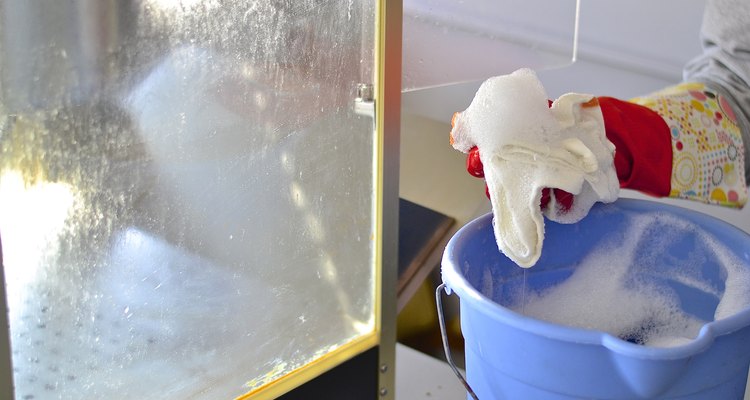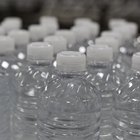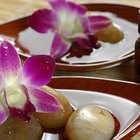
A popcorn machine in your home helps make for an authentic theater experience. These novelty machines are not without mess -- hot oil used to pop the corn kernels can splatter, resulting in a greasy smear in addition to any salt you might add to the finished popcorn before serving. Whether you have a small, countertop popcorn machine or a full-sized machine to complete a dedicated home theater space, regular cleaning is required to prevent oil turning rancid and to ensure proper operation.
Cleaning Products

The greasy buildup inside a popcorn machine is difficult to remove completely with hot water alone. Grease-cutting dish soap mixed with hot, soapy water work as effectively as it does for cleaning greasy dishes. Non-toxic orange or citrus cleaners also work well for cutting grease. Clean the inside and outside of the glass with an ammonia-free window cleaner or a mixture of equal parts white vinegar and water.
You can also find cleaning products marketed specifically for cleaning popcorn machines, particularly the hot kettle part of the machine. Different popcorn machines call for different cleaning products to clean the components. The type of product you choose largely depends on preference. Still, check your user's manual to ensure using anything other than the recommended product will not void the machine's warranty or affect its operation.
Before You Clean the Popcorn Machine

The kettle component heats up just as hot as a pan on the stovetop to pop the corn kernels. Many machines also have warming plates or a sliding warming drawer to keep the popcorn hot. Unplug the popcorn machine and allow all components to cool completely before attempting to clean the machine. The oil must be cooled completely before cleaning. In most machines, the kettle contains electrical heating elements and cannot be submerged for cleaning.
Regular Cleaning

Oil builds up fast in a popcorn machine, so the machine should be lightly cleaned after each use. Wipe up excess oil with clean, dry paper towels or a dry cleaning cloth before making the next batch. Wipe the inside of the machine with a damp cloth; pull out the removable tray, if applicable, and wipe it thoroughly with a damp cloth. Dry it carefully when you're done, to avoid rust in the popcorn machine.
Wipe the glass inside and out with window cleaner or vinegar solution to remove any lingering oil or fingerprints. If desired, follow by wiping the glass with a damp paper towel to rinse away any window cleaner or vinegar residue.
Thorough Cleaning

It is not necessary to change the oil or thoroughly clean inside the kettle between batches if you make several batches of popcorn in one day, but the oil should be dumped and the kettle cleaned after use if it is only used sporadically. The oil and lingering popcorn residue can go rancid if left in the kettle for extended periods. You can spray the inside of the kettle with non-toxic degreaser or hot, soapy water to clean the grease.
Spray with water to rinse any residue and wipe dry with paper towels. Instructions for certain machines suggest filling the kettle with cleaning solution and turning on the kettle to heat it before washing. Wipe down the rest of the machine as you would for regular maintenance.
Related Articles

Different Ways to Pop Popcorn

How to Troubleshoot a Fog Machine

How to Take Oil Stains Out of T-Shirts

How to Make Kettle Corn

Sauna Cleaning Requirements

Back to Basics Cocoa Latte Machine ...

How to Polish a Vintage Singer Sewing ...

How to Clean the Smell From the Inside ...

Why Should You Use Filtered Water in a ...

How to Get Gas Out of a Coat?

How to Make Aromatherapy Oil for a ...

Can I Put Canola Oil in a Spray Bottle?

Instructions for the West Bend Ice Tea ...

Homemade Daily Shower Cleaner Spray

How to Use a Smoker Box for Gas Grilling

How to Clean Khakis

How to Extract Oil From Rapeseed

How to Clean a Shearling Coat

How Popcorn Storage Affects Popping

How to Clean Cotton & Polyester Blends
References
Writer Bio
A former cake decorator and competitive horticulturist, Amelia Allonsy is most at home in the kitchen or with her hands in the dirt. She received her Bachelor's degree from West Virginia University. Her work has been published in the San Francisco Chronicle and on other websites.
Photo Credits
Karen Amundson/Demand Media